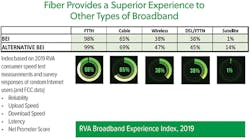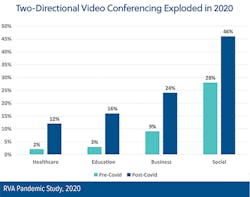The Longing for Fiber Is Long Overdue —
As alarming initial models pointed to a nearly 40 million virus deaths worldwide, an historic event occurred: roughly half the population of developed countries sheltered entirely in their homes for an extended time — supported solely by the Internet and its associated applications. In only a 2-month timeframe, RVA’s research for the Fiber Broadband Association showed an unprecedented doubling of the use of US residential two-directional video for work, school, medical, and social interactions.
We also saw that residents with poorer Internet had to ration the number of active users within a home, and endured much more unproductive time online.
Almost everyone now realizes just how important high-quality Internet has become.
InvisiLight® Solution for Deploying Fiber
April 2, 2022Go to Market Faster. Speed up Network Deployment
April 2, 2022Episode 10: Fiber Optic Closure Specs Explained…
April 1, 2022Food for Thought from Our 2022 ICT Visionaries
April 1, 2022Internet delivery is all about the path to the end user. A "pipe" analogy to describe those paths has aptly been used since the beginnings of the Internet. The events of the 2020 COVID-19 Pandemic brought about a fuller understanding of just how important these pipes/paths are. Pandemic-produced shifts have pressured providers to build more broadband infrastructure. A likely lasting swing to more work from home means a need to change the deployment equation which now indicates capacity to the large business enterprises may be overbuilt, and capacity to homes is certainly underbuilt.
Likewise, the COVID-19 Pandemic also altered US population shifts. After nearly a century of residential movement from rural areas to urban, the year 2020 saw a complete reversal due to the advantages of less density and more greenspace, combined with remote virtual connectivity. Coming autonomous vehicles, which will make occasional commutes more productive or relaxing, will likely only add to the movement. This makes solving the massive rural Internet divide ever more important. More pipes are needed — and fast.
No More Dumb Pipes
But are all pipes the same? In the late 1990s, some analysts referred to the Internet lines as dumb pipes with the implication that such conduits would become a commodity and would not be valuable to the companies that operated them.
By contrast, pipes carrying unique content were called smart pipes with the implication that they could be better monetized. This set off a wave of vertical integration, and network operators began purchasing media companies. These purchases may have been profitable business decisions, but the concept of creating smart pipes has proven more difficult than perceived. It is now generally accepted that network operators should not monopolize their pipe content (some flavor of the network neutrality concept.) At any rate, this diversion probably bled valuable funds away from real network improvement.
The year 2021 now offers us a better understanding of how Internet pipes should be differentiated. Internet pathways can indeed be uniquely better — but via quality, not "smartness". Using random sampling, we quantified the fact that different broadband methods have significant differences in download speed (the amount of data that can be transferred down quickly), upload speed (the amount of data that can be transferred up for, say, a video conference), latency (the speed at which one piece of information travels — think voice delays), uptime/reliability, and, by extension, consumer satisfaction. Delivery by fiber optic cable clearly gets the best ratings, followed by cable (hybrid fiber coax), and then finally DSL over copper telephone lines.
The Fiber Pipe Wins Because:
• optical signals can travel further and faster with light than electrical signals,
• fiber requires no troublesome electronic switches and amplifiers in the outside plant network, and
• a fiber optic cable leaks much less energy than does an electrical wire.
• Operators also see this advantage in terms of far lower maintenance costs for fiber networks.
• Further, customer satisfaction due to less downtime and better productivity creates powerful barriers to churn.
• Finally, fiber is called future-proof because its broadband capacity can be increased almost infinitely to meet ever increasing needs.
Wireless, or Not?
But what about wireless signals that seemingly do not travel in a pipe? Yes, wireless is an important complimentary delivery method because of the convenience factor. The wireless signal can travel in all directions — but it will never win the performance race because of the inefficiency of transferring energy through the air. Actual wireless/through-the-air delivery must be kept to a minimum to win the highest performance possible, optimally the last 100 feet in a home, or the last 500 feet in a neighborhood. Backbone pipe networks — now almost always fiber — must carry the "wireless" communication most of the way.
The same is true for satellites that do not use pipes. Although new, low orbital satellites may have an important place in serving very remote or hard-to-reach areas, satellite Internet can never compete against fiber in terms of performance.
In North America, there is finally a clear need/incentive to greatly increase the pace toward better Internet. Aided mostly from private investment, but to some degree with recently increased national subsidy for rural areas, providers consisting of the large Tier-1 telecoms, smaller regional and rural telephone companies, MSO cable companies, rural electric coops, public municipalities, and private competitors, are all mobilizing. While there are, of course, far too many areas with little competition, America has more facilities-based competition (competitors that must build their own pipe to compete) than almost anywhere in the world.
Now that these 1,100 diverse service providers finally fully grasp the importance of the pipe, they are moving quickly in competitive areas where they are already invested (the brutal Red Ocean in the words of Mauborgne and Kim). They are doing so to avoid losing their core business and to ensure their future. (Some recently learned this lesson too late and entered Chapter 11). Others are building pipe in less competitive areas (the Blue Ocean) with a unique solution that could provide an excellent cash flow for years to come.
The race is on! The public is waiting.
For more information, email [email protected] or visit www.RVALLC.com.






